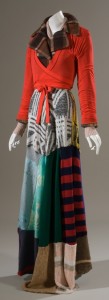
The elegant Eirene Gown, named for the Greek goddess of peace, is sewn from silk hand-gathered from naturally-hatched wild silkworms and woven on antique looms in a small mill in India. Its delicate coral hue is derived from a dye extracted from the root of the Madder plant, growing in a war zone in the high valleys along the border between Afghanistan and Pakistan. Chevron-shaped appliqués along the neckline come from the discarded part of the shells of the Mabe pearl, gathered and turned into jewelry by women of the Zanzibar Women’s Shellcraft Cooperative. Estimated price tag for the dress: between $3000 to $6000.
Top Shop it ain’t, and it ain’t on sale either: designer Katie Brierley, who produces her Isoude collection “in a slow and sustainable manner,” created the frock for the Fashion Institute of Technology’s new exhibition, Eco-Fashion: Going Green, on show until November 13, 2010. The antithesis of easily-tossed togs on sale in cut-price clothing stores, the Eirene gown is one of more than 100 garments and accessories in the New York exhibition.
The Eirene gown is beyond my clothing budget – in fact, its cost could easily feed a family of four for six months, according to the U.S. Department of Agriculture. Nevertheless, I think there’s a lot to be said for using durable fabrics and paying garment workers decent wages. The Victorians knew about durability (if not the decent wages): silks, for example, were once handed down several generations, long before it was chic to recycle. One example in the exhibition is an 1840 ivory-and-yellow-striped silk dress that was made from re-purposed 18th century silk.
Recycling is still in vogue, and not just for devotees of thrift stores. A 1994 recycled dress by Malian designer Xuly Bet is stitched together from mis-matched sweaters and topped with a jacket created from worn pantyhose. I can’t say it’s exactly to my taste, since it reminds me of the lumpy jumpers I wore as a clueless teen. Yet salvaged trash can translate into style: A chic 2010 necklace by Tatiana Pages of Origomu is made from intertwined plastic six-pack rings, which if left to drift in the ocean can strangle sea creatures.
Concern for wildlife has driven earlier fashion trends, and Eco-Fashion cleverly traces the evolution of environmental consciousness among the elegantly-inclined. The National Audubon Society was incorporated in 1905 to protect birds from slaughter by plume-hunters when “fancy feathers” were all the rage. An example of such depredation is a 19th century silk capelet (a small shoulder cape) lavishly adorned with pheasant, duck, peacock and kingfisher feathers and trimmed with swansdown. Later, leather was replaced by plastic pleather and silk with nylon. These substitutes are hardly benign: plastic shoes and bags give off toxic gases as they decompose, and nylon production generates nitrous oxide, a greenhouse gas that traps 310 times as much heat as carbon dioxide.
These impacts explain the increasing demand for eco-friendly fibers such as banana bark fiber, which can be found in a new line of men’s underwear made by Aussie Bum; hemp, a hardy plant that requires little water and few chemicals; and Tencel, a biodegradable fabric made from wood pulp cellulose. These last two are blended in a beautiful purple dress by Nina Valenti for naturevsfuture. The use of organic cotton is on the rise: according to the 2009 Organic Cotton Market Report, production of the fiber grew by 20 percent over the previous year, reaching 175,113 metric tons, although it still accounts for less than 0.8 percent of global cotton production. One example of the textile’s use is a sublime black-and-white evening gown made from organic Tunisian denim by Edun, an ethical clothing label founded in 2005 by rock musician Bono and his wife Ali Hewson. As Hewson told the London Times in 2006, “I really don’t want to wear clothes created from someone else’s despair.”
Image courtesy of the Fashion Institute of Technology
An interesting read. That is quite the gown. Some of what you mentioned is over the top for me as well.
I always look for eco freindly clothing and do probably 90% of my clothing is cotton.